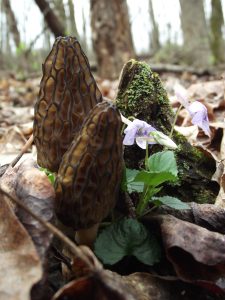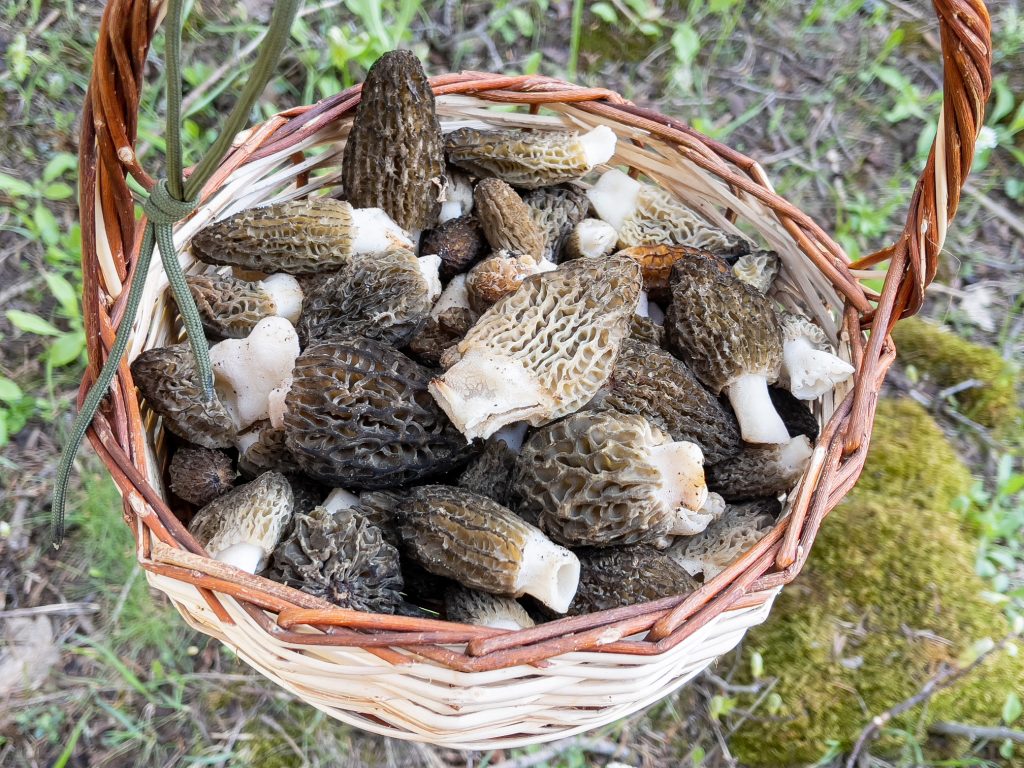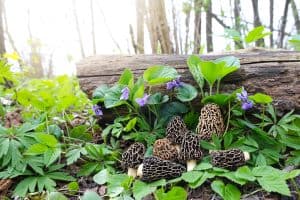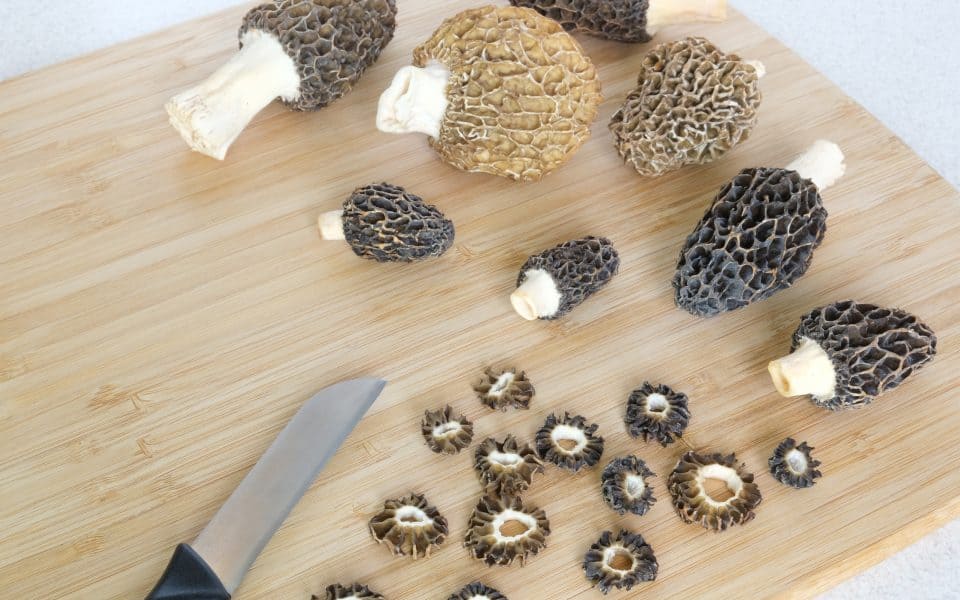Those spring turkey scouting excursions and hunts can become a lot more valuable, and tastier, if you have keen eyes and are willing to do some walking. About the time the springtime wild plants begin to emerge, another treat that we know as the “morel mushroom” begins fruiting and can become a favorite delicacy for your family. It’s short window of growth makes it imperative to get out early and often whenever conditions are right to get your hands on perhaps one of the most unique offerings in our creation.
 Morel mushrooms are truly a treat that many people cannot wait to enjoy each spring and are known by various names depending on your geographic location. Other common names for morels include Molly Moocher, dry-land fish, and sponge mushrooms. No matter what you call it, you’ll likely agree that the wait and the search are well worth it whenever you have them frying in the skillet.
Morel mushrooms are truly a treat that many people cannot wait to enjoy each spring and are known by various names depending on your geographic location. Other common names for morels include Molly Moocher, dry-land fish, and sponge mushrooms. No matter what you call it, you’ll likely agree that the wait and the search are well worth it whenever you have them frying in the skillet.
Outdoorsmen wait for the nighttime temperatures to warm up and soil temperatures to reach the 50’s which promotes the growth of the mushrooms. Commonly the morel mushrooms begin appearing in abundance around the last week of March and continue until early May. Inconsistent temperatures and unseasonably dry conditions can cause sporadic growth. Optimum growth will occur during periods of warming spring weather with periodic rain showers. The return of cold or cool weather can spell disaster for the continued growth of the morel and shorten your season which is unfortunate for all who love these delicacies.
Morels grow best on the north and east slopes of hills and valleys but are not limited to such locations. Don’t be surprised however if you find them growing in some strange locations. Grassy field edges, apple orchards and fence rows can even produce large quantities. Prime locations for morels to grow will change throughout the season as temperatures rise. You may find them on south slopes early in the season, but then on north and east slopes later in the season. The most important factors for morel growth are moisture, shade and decaying matter. Areas that have experienced wildfires or controlled burns can produce large numbers of morels the following couple years because of accelerated decay of forest matter.
They grow near a variety of trees such as poplar, ash, elm, cherry, apple and others. Again, this is dependent upon your region. Morels range in size from less than ½ of an inch to more than five inches and their colors can be from white to almost black.
Each variety and color have two features that remain constant and are seen as tell-tale signs that it is truly an edible morel. Those features are the conical or cone shaped top and the fact that they are hollow. The conical tops can help you locate the morels as you scour the hillsides. When you find a mushroom, you’ll likely find others in the vicinity. The more boots you have on the ground, the more mushrooms you’ll find so take your kids and friends along and you’ll be surprised how much fun they’ll have.
Given the fact that spring weather arrives at different times in varying regions, you can’t always rely on exact dates for the mushrooms to come up. Unseasonably cold or dry weather will slow morel growth. Warmer days and nights along with periodic rains will accelerate growth.

Keeping an eye on social media of your outdoors friends who live in your region will give you a good idea of whenever the morels begin to emerge. People like to brag about the quantity and size of their find and you can use their information as a map to where and when to hunt. There is even a website that is dedicated to mapping where and when morels emerge all across America. www.thegreatmorel.com has an interactive map where users can upload locations, photos and information that can help fellow hunters find morels.
A common practice for avid morel hunters is to collect them in mesh onion sacks so that spores can fall from the harvested mushrooms as you walk. Whenever you do, find a location that is conducive to growing morels that you can return to year after year whenever conditions are right, and you will likely find more. Due to the high price of morels, public hunting areas can become overrun with hunters who sell their finds. Whether you hunt for personal use or sale, treat mushroom hunting as any other excursion into the woods and get permission from landowners if you plan to hunt away from your own property.
Nearly everyone who hunts mushrooms has their own special recipe for how to cook them. Any fish fry batter or good old-fashioned cornmeal can be used as a coating before you deep fry them. Cook them until they suit your taste and just watch them disappear from the plate when you put them on the table. They can also be sauteed and served alongside your favorite dinner dish.
 Of course, you need to use caution when you pick mushrooms that you’re going to eat if you are not familiar with morels. If you are unsure about what you are hunting, then you need to ask someone who is familiar with mushroom hunting to go along with you, or there is a wealth of knowledge along with photos on the internet that can help you identify various types of morels. However, since you may be in the hills without a signal for your phone, a good old fashioned book that identifies edible mushrooms may be better. You should also be familiar with what is referred to as a false morel which is poisonous. Again, you can find photos and information about false morels online. Typically, a false morel will not be as firm and conical as a true morel. The tops are limper and wavier than those found on a true morel.
Of course, you need to use caution when you pick mushrooms that you’re going to eat if you are not familiar with morels. If you are unsure about what you are hunting, then you need to ask someone who is familiar with mushroom hunting to go along with you, or there is a wealth of knowledge along with photos on the internet that can help you identify various types of morels. However, since you may be in the hills without a signal for your phone, a good old fashioned book that identifies edible mushrooms may be better. You should also be familiar with what is referred to as a false morel which is poisonous. Again, you can find photos and information about false morels online. Typically, a false morel will not be as firm and conical as a true morel. The tops are limper and wavier than those found on a true morel.
Some days can deliver an abundance of morels, however, others can simply supply a nice walk amidst the creation. Either way you’ll give yourself an opportunity to get out of the house and enjoy the great outdoors and do some turkey scouting as you walk. Turkeys will eat morels and many times you’ll find scratching in and around the areas where morels grow as the turkeys tend to scratch the leaf litter in search of bugs, nuts and buds. In many states the weeks that the morels can be found will coincide with turkey season so there’s a good chance you can bag a bird and fill a bag with morels on the same trip.
The wait is over. Spring has sprung and so have the mighty morels. Take a bag, take some friends and come home with a better appreciation for the great outdoors and the many wonders that can be found whenever you take a closer look.










